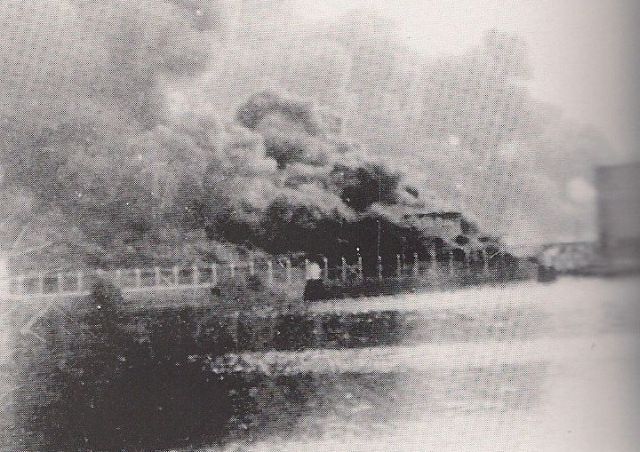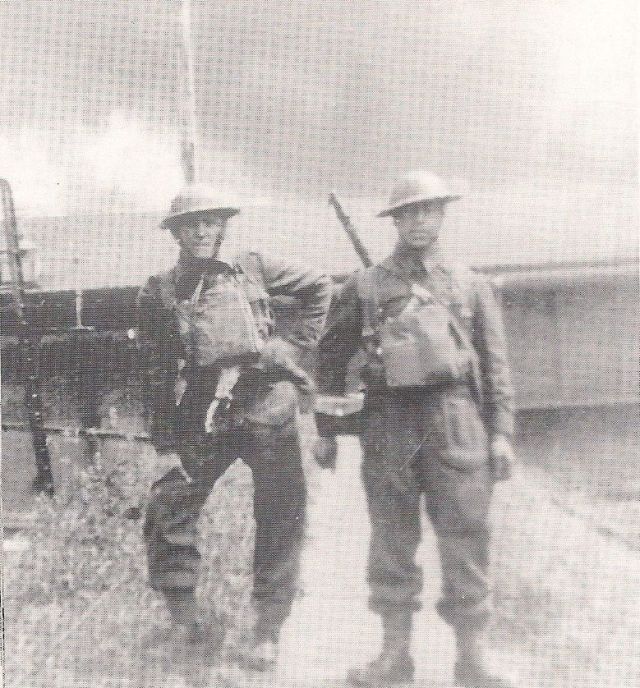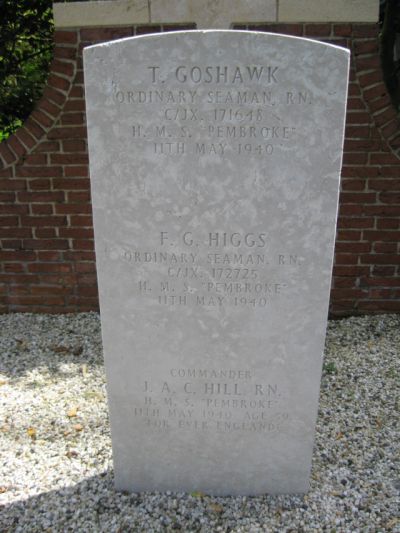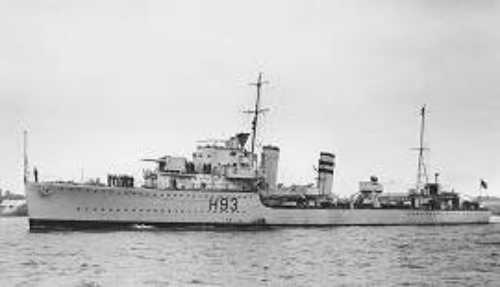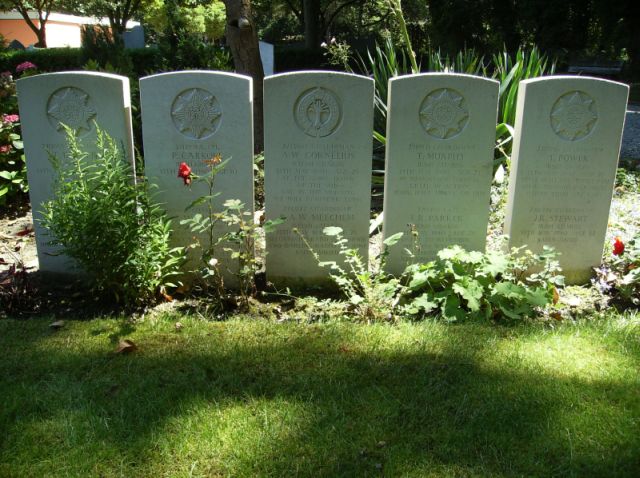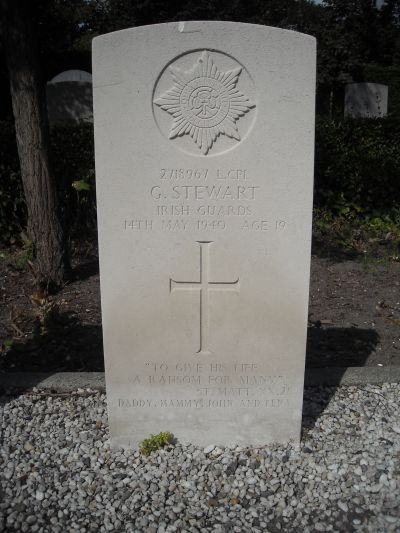Introduction
On Friday the 10th of May, 1940, the Dutch neutrality was ravaged when the German armies attacked our country. The Dutch army was insufficiently trained and equipped to counter the German invasion. Without help from outside it would be a battle without the slightest chance. This help from abroad did arrive. Not only from the French, who fought in the province of Noord-Brabant, but also from the British. During the days in May 1940 British troops were active in several places the Netherlands, but mainly in Hook of Holland. The arrival of our allies enhanced the optimism both amongst the Dutch forces and amongst their country fellow men. Together with the British it ought to be possible to beat the Germans. But the British had not come to start a counter offensive.
Definitielijst
- invasion
- Armed incursion.
- neutrality
- Impartiality, absence of decided views, the state of not supporting or helping either side in a conflict.
- offensive
- Attack on a smaller or larger scale.
Images
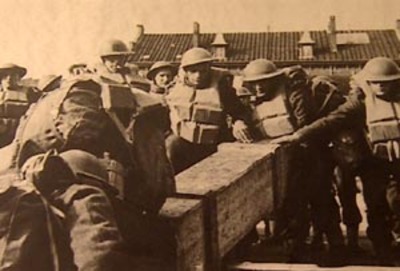 British troops coming ashore at Hoek van Holland Source: Andere Tijden.
British troops coming ashore at Hoek van Holland Source: Andere Tijden.The German invasion and Operation XD
The German Invasion
After the German invasion of Poland on 1 September, 1939, and the subsequent declarations of war by Great Britain and France, Europe was heading for a new great war. In conformity with its foreign policy of the preceding decennia the Netherlands had made a declaration of neutrality. The Germans however, estimated a passage through the south of the Netherlands to be crucial for their advance to France, contrary to their strategy in 1914. During the night of 9 to 10 May the Germans indeed crossed the Dutch border. That morning Her Majesty Queen Wilhelmina made a statement to her people in a proclamation which contained the following message: “[…]during the past night the German Wehrmacht suddenly attacked our territory without the slightest warning[…]”
The Netherlands had announced the mobilization in August 1939. The Dutch Army was therefore prepared and alert. But the forces were poorly trained and their equipment was completely outdated. The troops had been busy building reinforcements and fortresses and had had little time for maneuvers. Also there was a shortage of a lot of material and the equipment they did have, was outdated. For example: artillery pieces that dated from 1868 were still in use. The German army, on the contrary, was large, strong and well equipped. It was an uneven battle, certainly if the Dutch were not to receive help from abroad.
As part of their plan of attack the Germans had dropped paratroopers around the city of The Hague and occupied the airfields of Ypenburg, Valkenburg and Ockenburg. [East north and south of The Hague]. With these troops they threatened the Dutch government centre. There was a real threat that the country’s government would be surrounded and taken prisoner. Minister of Foreign Affairs Eelco Nicolaas van Kleffens had flown to England with an amphibian aircraft. The Dutch government started from the presumption that Great Britain would come to the rescue. After all, the British had sent forces to France and Norway. Van Kleffens knocked at the doors of the British supreme command, but originally they reacted negatively. There were no troops available and even if there had been troops available these would never arrive in time to turn the battle decisively around. But an agreement existed, established with the Dutch government, about an extremely secret mission which had now been activated in order to have four small demolition teams at the ready.
Operation XD
In the morning of May 10th the British War Cabinet immediately had assembled in order to discuss the German attack on the Low Countries. One of the items on the agenda was related to the Dutch and Belgian strategic stores and infrastructure that had to be kept out of the hands of the attackers at all cost. (Like gold, oil, and electricity, but also harbor installations and aeronautical facilities.) In order to achieve this, demolition parties consisting of men of the Kent Fortress Royal Engineers were sent to IJmuiden (Amsterdam), Hook of Holland (Rotterdam) and Flushing by boat. The code name for these destructive actions was Operation XD. Engineer George Letchford who participated in the Rotterdam demolition party remembers: “On our way we received a briefing about the mission and all members were issued Dutch guilders in case someone would be cut of and had to find his own way home”.
The Engineers of the demolition parties continued their way to their targets. But their destruction orders were canceled by General Winkelman the supreme commander of the Dutch Army. The Germans were not yet in the area and the Dutch Army was holding its positions at several places. Winkelman did not yet want to accept a capitulation and did not want to make any irreversible decisions. Some of the Engineers accepted other tasks like for example Corporal Blake, who in Hook of Holland was awaiting new instructions: “We manned trenches together with the Dutch soldiers. We were under German fire; we received orders to return to our own positions.” The Dutch supreme command decided as yet on May 13th that the destructive actions were to be carried out. The British Engineers set fire to the oil stores in Amsterdam and Rotterdam. The Germans succeeded quite soon, after their arrival to kill the fires, so only small quantities were lost.
For the British Engineers in Hook of Holland the Dutch had also another order. In the branch of the Rotterdamse Bank at De Boompjes in Rotterdam a small part of the Dutch gold stock had been stored. The gold bullion of 937 bars with a value of 22 million guilders should not end up in the hands of the Germans. About six men were carried in a truck to Rotterdam, amongst them the commander of the demolition party, Commander Hill. “We were hiding under a tarpaulin, so we stayed out of sight” Letchford says. The next morning the white crates with gold bars were loaded onto a pilot’s boat. Hill returned to Hook of Holland with the boat, the other Engineers went by truck. The gold bars however would never reach Hook of Holland. In the morning of the 10th of May, the Germans had laid magnetic mines in the Nieuwe Waterweg. And between Vlaardingen and Maassluis the pilot’s boat hit one of these mines and sunk. Commander Hill, Ordinary Seamen Higgs and Goshawk and part of the crew of the pilot’s boat lost their lives in this accident. The three British seamen have been buried at the Emaus graveyard in Vlaardingen. Two months after the accident, the Germans succeeded to lift 816 bars out of the wreck. In 1946 and 1947 again 111 bars were salvaged. The last 6 bars have never been located until today.
Definitielijst
- capitulation
- Agreement between fighting parties concerning the surrender of a country or an army.
- invasion
- Armed incursion.
- mobilization
- To make an army ready for war, actually the transition from a state of peace to a state of war. The Dutch army was mobilized on the 29 August 1939.
- neutrality
- Impartiality, absence of decided views, the state of not supporting or helping either side in a conflict.
- paratroopers
- Airborne Division. Military specialized in parachute landings.
- strategy
- Art of warfare, the way in which war should be conducted in general.
- Wehrmacht
- German armed military forces, divided in ground forces, air force and navy.
Images
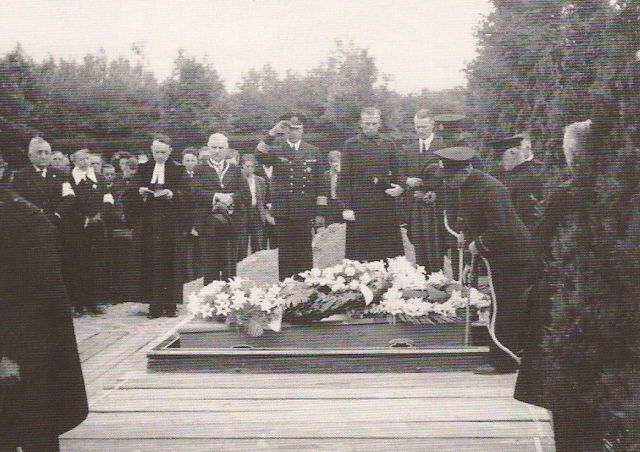 Three British sailors are being buried at the Emaus Cemetery at Vlaardingen. Source: Stadsarchief Vlaardingen.
Three British sailors are being buried at the Emaus Cemetery at Vlaardingen. Source: Stadsarchief Vlaardingen.Harpoon Force
Harpoon Force
Finally the British government decided as yet on 11 May to come to the aid of the Dutch. The 20th Guards Brigade, composed of the 2nd Batallion Irish Guards, the 2nd Batallion Welsh Guards and the 5th Batallion, The Loyal Regiment, was the only force that was ready for battle. The Irish Guards for example were trained in the preceding months to follow the 1st Batallion Irish Guards to Norway and was therefore immediately available.
But, on May 10th the Whitsunday weekend leave had started for the Guardsmen and many of them were on their way to their families and relatives. When the War Office was notified of the attack by Germany on the Netherlands, Belgium and France, the leave was canceled immediately. Trains were halted and the soldiers had to return to their bases. Like Guardsman Bryn James: “The train stopped suddenly and military police entered the compartment: ‘OUT’ they said. We did not have a clue of what was going on. We had to change into another train and drove back.” Some of the soldiers were already too far away to be able to return in time. The 20th Guards Brigade had been transferred to the area around Turnbridge Wells. According to the war records of the Irish Guards this was done as a consequence of the rumors that German paratroopers had landed in various locations in county Kent, which later on appeared to be not true. When the 20th Guards Brigade arrived in Turnbridge Wells it was decided to go and help the Dutch as yet. The 2nd Batallion Irish Guards was far from complete because of the leave. In order to bring the Batallion up to strength, a rifle company of the 2nd Batallion Welsh Guards was added, and the operation got the code name Harpoon Force. The unit was under the command of Lieutenant-Colonel Joseph Haydon.
The crossing and arrival
The total number of 651 men were carried to Dover by train where SS ‘Canterbury’ and SS ‘Maid of Orleans’ were docked. Their captains wished to sail as soon as possible in order to cross the North Sea under the cover of darkness. Food, material and other stores were hurried onboard. Because of the rush, many Guardsmen didn’t even know what their destination was. Just like Percival Tilley. He met Sergeant Obie Walker who asked Tilley: “Do you like tulips?” Tilley answered that they were not his favorite flowers after which Walker told him: “You better learn to love them quickly, we are leaving for Holland tonight.” Shortly before their departure from Dover, the Dutch Captain Phillips was added to the Harpoon Force as an interpreter. Only a few of the passengers and crew knew what the purpose of the mission was. One of them was of course Commander Haydon who had received the following orders from the War Office: “It will be your task to advance to The Hague and to cooperate with the local authorities and troops in order to repair the situation and to safeguard the Dutch government.” The British would comply with requests from the Dutch commanders, unless Haydon would judge that such compliance would unnecessarily endanger the lives of his men.
In the early morning hours of Whitsun Monday (13 May) the British convoy arrived at Hook of Holland. In the harbor HMS Verity and HMS Venemous were moored. These ships had disembarked marines in order to prepare the arrival of the Harpoon Force. The British ships moored at the quay and disembarkation started. Around them could be heard the cheering: “The British have arrived!” Their arrival spread optimism with both the civilians and the Dutch troops. They started from the presumption that the Guards came to support the Dutch Army. It was therefore a disappointment when the British started to dig in within the defense lines which had been laid around the Hook of Holland by the Dutch. Haydon addressed the Dutch commander wanting to obtain transport to advance towards The Hague. Contact was made with the troops in The Hague and they agreed to send the trucks.
They must be Germans!
Towards noon Haydon and his adjutant Captain Henry Phillpots walked up and down the quay within their perimeter. They watched a crane that was discharging the British equipment and supplies. Suddenly a number of cars entered the quay led by motor cyclists. As soon as they came to a halt, from each car a man stepped down. Phillpots did not trust the situation. “They must be Germans”, he said to Haydon and drew his handgun. One of the men approached the two officers, bowed and said: “Her Majesty the Queen of the Netherlands has arrived”. Haydon and Phillpots looked at the cars and indeed there was the Queen of the Netherlands. Haydon welcomed Her Majesty while Phillpots discussed the situation with the commander of HMS Hereward, which was to be made available to Her Majesty the Queen. Wilhelmina wanted to go to Breskens in order to govern the country from there. Her luggage was sent aboard and HMS Hereward left the harbor. On the way the ship was warned about a bomb raid on Breskens and it was decided to take the Queen to England.
In the meantime Haydon was approached by the Dutch commander with the request to send his troops to Rotterdam in order to help fighting the German paratroops that had landed there. The Brit refused this as he did not want to endanger the lives of his men unnecessarily. Some time later he also refused a request to send his men to Amsterdam. Colonel Snoeck was the commander of the 2nd Batallion of the 39th Infantry Regiment, one of the units charged with the defenses of the Hook of Holland. Also he had been optimistic when the British had arrived, but now he was disappointed: “Cooperation with the British was impossible. Not a single request for attacking nor defending was answered. They only did whatever they liked themselves.”
Air attack
Towards the afternoon the British sentries again allowed a row of cars to enter onto the quay. This time it was the Dutch government which had decided to take refuge in England. A bit later the British diplomatic corps and some Dutch industry officials, like the Philips family, reported to the Hook of Holland. Together with the government officials they left for England. In the meantime also the trucks from The Hague had arrived, but the troops did not need to advance anymore as the Dutch government had been herded into safety. Apparently the Germans had picked up the smell of something that was happening at the Hook of Holland and carried out an air raid. At this air raid seven Guards lost their lives and 23 got wounded. Captain Phillpots was one of those. Because he was of the opinion that the medics had their hands full, he decided to hide his wounds. Later, he would be awarded the Military Cross for this unselfish behavior. Haydon contacted the War Office in London. He was told that his forces would be reinforced with a second Batallion. Haydon explained that extra manpower would not change the situation. What he wanted was air support and heavier weapons.
In the morning of May 14th Haydon again contacted the War Office. No second Batallion would be sent over to the Netherlands. The Harpoon Force had complied with its task and had to count with the fact that they would be evacuated that same day. At 09:30 a new air raid by the Germans took place. This one was heavier than the day before, but the British had improved their diggings. In spite thereof the Guards again lost four men.
Definitielijst
- Batallion
- Part of a regiment composed of several companies. In theory a batallion consists of 500-1,000 men.
- Brigade
- Consisted mostly of two or more regiments. Could operate independently or as part of a division. Sometimes they were part of a corps instead of a division. In theory a brigade consisted of 5,000 to 7,000 men.
- Infantry
- Foot soldiers of a given army.
- paratroopers
- Airborne Division. Military specialized in parachute landings.
- raid
- Fast military raid in enemy territory
- Regiment
- Part of a division. A division divided into a number of regiments. In the army traditionally the name of the major organised unit of one type of weapon.
Images
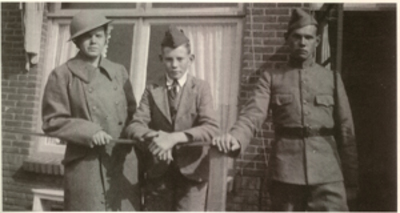 A Dutch boy poses with a British and a Dutch soldier. Source: Andere Tijden.
A Dutch boy poses with a British and a Dutch soldier. Source: Andere Tijden.Withdrawal and aftermath
Withdrawal
Commander Haydon also was worried about the Germans preparing a possible ground attack. This concern was certainly justified if the Germans would be deploying tanks. The British did not have the adequate armament to fight an equal battle. Haydon was aware that the War Office planned a withdrawal and retired his troops into the village. During the air attacks, material was lost amongst which also radios. Therefore the communication with destroyers off the coast was impossible. A soldier climbed the vanes of a windmill and succeeded to make contact by means of flag signals. There was a deliberation with the captain of HMS Malcolm. It was decided to withdraw the British from the Hook of Holland. For this purpose only three destroyers were available: HMS Malcolm, HMS Vesper and HMS Whitshed. There was lack of space to load everything onboard those ships. The Guards therefore received orders to take along just what they could carry. They embarked on the destroyers by half platoon. “Herewith they marched along the quay and stepped onboard as if they were parading in front of Buckingham Palace. It was marvelous to watch that,“ said a crewmember of HMS Whitshed.
A little after 11:00 the destroyers left Hook of Holland. Nine Bristol Blenheim fighter aircraft had to cover the retreat. The Germans attacked the retreating British again with their aircraft. The Royal Navy ships and the Blenheims of the Royal Air Force countered the attack with all firepower they had. The Germans did not inflict damage to the convoy. At 20:00 that evening the British arrived at Dover where the Harpoon Force spent the night. The next day the unit had returned to Camberley. The improvised Batallion had returned to the spot which they had left in such a hurry, some 48 hours earlier.
Aftermath
Hook of Holland in the meantime was left quiet and desolate. The limousines were left on the quay riddled with bullet holes. The Dutch army trucks were burning. The small ammunition depot of the British had also been set on fire and explosions sounded in the area. All over the village the pieces of equipment they had left behind were spread around, which were the only traces of the presence of the British. Today, the only reminders of those days in May so full of insecurity and confusion are the ten British graves on the municipal churchyard of Hook of Holland and the grave of Lance Corporal Stewart in ‘s Gravenzande.
All in all it had been four days full of confusion for both the British and the Dutch. There was a lot of disappointment amongst the Dutch troops and civil population. They had been hoping and expecting that the British troops would set up a counter attack against the Germans. Together with “Tommies” the nazi war machine could be destroyed they thought. For the British however a counter offensive had not played a part. They had only crossed over to the Netherlands for defensive actions: the destruction of strategic stores and material and infrastructure and the evacuation of the government. This last task had been complied with and the British had also been able to play a part in the evacuation of Queen Wilhelmina. The demolition actions had mostly failed. Many facilities did end up in the hands of the Germans and would remain so for the next five years. “The Tommies are coming” appeared to be a wrong statement; they only returned to liberate the Netherlands four to five years later.
Definitielijst
- Batallion
- Part of a regiment composed of several companies. In theory a batallion consists of 500-1,000 men.
- nazi
- Abbreviation of a national socialist.
- offensive
- Attack on a smaller or larger scale.
Images
Information
- Article by:
- Pieter Schlebaum
- Translated by:
- Fred Bolle
- Published on:
- 19-01-2025
- Feedback?
- Send it!
Related books
Sources
- BRAZIER, C, XD Operations, Pen & Sword Books Limited, Barnsley, 2005.
- BRONGERS, E.H., De slag om de residentie 1940, Hollandia, Baarn, 1983.
- FITZGERALD, D.J.L., History of the Irish Guards in the Second World War, Gale & Polden, Aldershot, 1949.
- The National Archives ADM 202/401: `Harpoon': Defensive action covering withdrawal from Hook of Holland
- The National Archives WO 106/1667: War Office: Directorate of Military Operations and Military Intelligence, and predecessors: Correspondence and Papers Operation Harpoon
- The National Archives WO 166/4105: War Diary 2nd Battalion Irish Guards May 1940
- Archief Regimental Headquarters Irish Guards (thanks to D.P. Cleary MBE)
- Boegheim, L.M.J., De ramp met de loodsboot 19A op de Nieuwe Waterweg, Terugblik, 1998 (Dutch article, issue unknown)
- History of the Irish Guards in World War Two
- Dutch television program: Andere Tijden
- World War II Memories
